The chin-up is an upper-body exercise that involves hanging from a bar by your hands and pulling your body upward.
It’s similar to the pull-up, except you do it with your palms facing you, which makes your biceps work harder.
Performing the chin-up is challenging because it requires a lot of upper-body strength and coordination, which means it can be especially difficult for new weightlifters.
Fortunately, there are several chin-up variations that act as a smooth on-ramp and allow you to progressively build the strength you need to perform proper chin-up form.
In this article, you’ll learn what the chin-up is, its benefits, which muscles it works, how to do a chin-up with proper form, the best chin-up alternatives, and more.
Table of Contents
+
What Is a Chin-up?
The chin-up is an upper-body exercise that involves hanging by your hands with your arms straight, and then pulling your body upward until your chin rises above your hands.
Although you can perform the chin-up by hanging from anything sturdy (a tree branch or attic rafter, for example), most people prefer to use a chin-up bar. A chin-up bar is a horizontal bar commonly attached to the top of heavy-duty gym equipment. For example, in most gyms, you’ll find a chin-up bar attached to a power rack or cable pulley machine.
Pull-up vs. Chin-up
The pull-up and chin-up are similar exercises that involve pulling your body upward until your chin rises above a bar. The main difference between the chin-up and pull-up is how you grip the bar.
A chin-up grip is supinated (palms facing toward you) with your hands about shoulder-width apart, whereas a pull-up grip is pronated (palms facing away from you) with your hands just outside shoulder-width.
These differences subtly change which muscles each exercise emphasizes. For instance, the pull-up trains your lats and lower traps slightly more than the chin-up, and the chin-up trains your biceps marginally more than the pull-up.
That said, these differences are minor, and the primary reason to do one over the other is to keep your workouts interesting and avoid shoulder and elbow overuse injuries, which can occur when you do the same exercise for an extended period.
In other words, you can use chin-ups and pull-ups interchangeably in your training, though it’s best to alternate between the two periodically.
A good way to do this is to include the chin-up in your program for 8-to-10 weeks of training, take a deload, then replace the chin-up with the pull-up for the following 8-to-10 weeks of training.
This is how I personally like to organize my training, and it’s similar to the method I advocate in my fitness books for men and women, Bigger Leaner Stronger and Thinner Leaner Stronger.
(And if you’d like even more specific advice about what exercises to include in your training program to reach your health and fitness goals, take the Legion Strength Training Quiz, and in less than a minute, you’ll know the perfect strength training program for you. Click here to check it out.)
Chin-up: Benefits
1. It trains most of your upper body.
Studies show that the chin-up effectively trains all of the muscles in your back, including your lats, traps, erector spinae, rhomboids, teres muscles, and infraspinatus.
Moreover, the chin-up also trains your core, pecs, deltoids, serratus anterior, and biceps to a high degree, making it a highly effective exercise for gaining muscle and strength across most of your upper body.
2. It’s scalable.
Lifting your entire body weight up to a bar requires a lot of strength, which means the full bodyweight chin-up isn’t always a great place to start if you’re new to weightlifting.
Fortunately, there are several “easier” versions of the chin-up, such as the chin-up hold, eccentric chin-up, assisted machine chin-up, and band-assisted chin-up, that train the same muscles as the regular chin-up and allow you to develop the strength you need to progress to the real McCoy.
Once you can do several reps (usually 10 or more) of the bodyweight chin-up without resting, you can also make the exercise more challenging by snatching a dumbbell between your thighs or strapping a weight plate around your waist using a dip belt (also known as the weighted chin-up).
In other words, the chin-up is highly scalable—no matter how strong you are, there’s a chin-up variation that will suit your experience and strength level and challenge you to get stronger over time.
3. You can perform it almost anywhere.
Like most bodyweight exercises, the chin-up requires very little equipment—only something sturdy to hang off.
This means you can perform the chin-up exercise almost anywhere, including in a gym (or home gym) with a chin-up bar, at home using an attic rafter or porch roof, or in a park using a tree branch or jungle gym.
The chin-up feels the same no matter where you perform it, too.
This isn’t the case with similar exercises like the lat pulldown, which can feel very different depending on the machine you’re using. For example, you might find you can lift 100 pounds on the lat pulldown machine at your gym but significantly less when you do the same exercise in a different gym with another lat pulldown machine.
(This has to do with how equipment manufacturers configure their machines, not because you lose or gain strength when you switch gyms.)
This makes the chin-up easier to track than a machine alternative—10 reps with your body weight is the same no matter where you perform them—which is important for ensuring you progress over time.
Chin-up: Muscles Worked
The main muscles worked by the chin-up are the . . .
- Latissimus dorsi
- Trapezius
- Rhomboids
- Infraspinatus
- Teres major and minor
- Erector spinae
- Rear deltoids
- Biceps
It also trains your pecs, abs, serratus anterior, and lateral (side) deltoids to a lesser degree, too.
Here’s how the main back muscles worked by the chin-up look on your body:
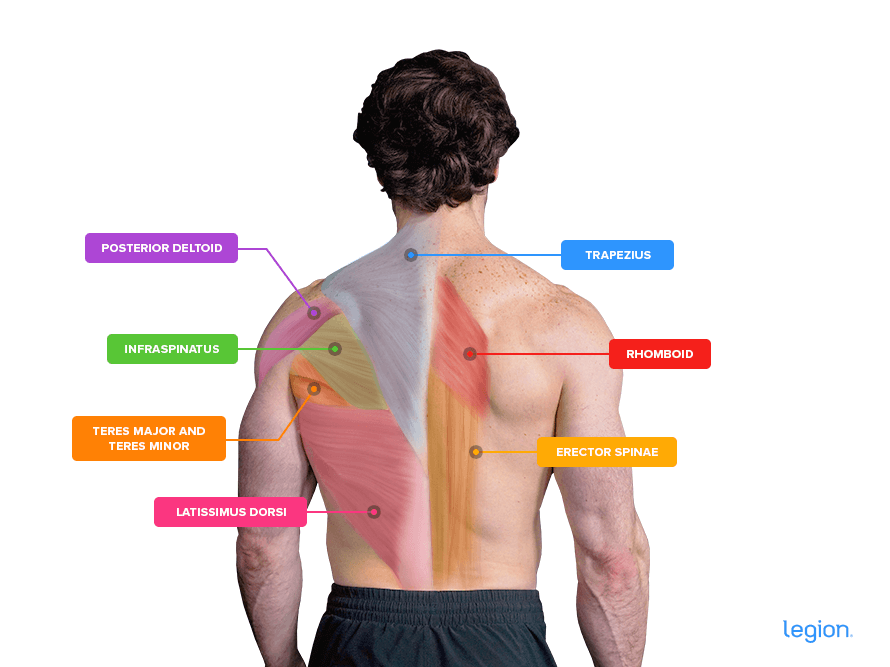
Pull-up vs. Chin-up: Muscles Worked
Some say that the pull-up and chin-up are very different exercises that train entirely different muscles, but this is mostly puffery.
The truth is that the pull-up and chin-up are almost identical exercises that train the same muscles to a similar degree. Research shows the pull-up trains the lats and lower traps slightly more than the chin-up, and the chin-up trains the biceps and pecs slightly more than the pull-up, but these differences are piffling, so it’s difficult to say whether they have any meaningful effect on long-term muscle growth.
In other words, you can use the chin-up and pull-up interchangeably in your training or alternate between them every 8-to-10 weeks of training, as I recommend in my programs for men and women.
How to Do the Chin-up
The best way to learn how to do a chin-up is to split the exercise into three parts: set up, pull, and descend.
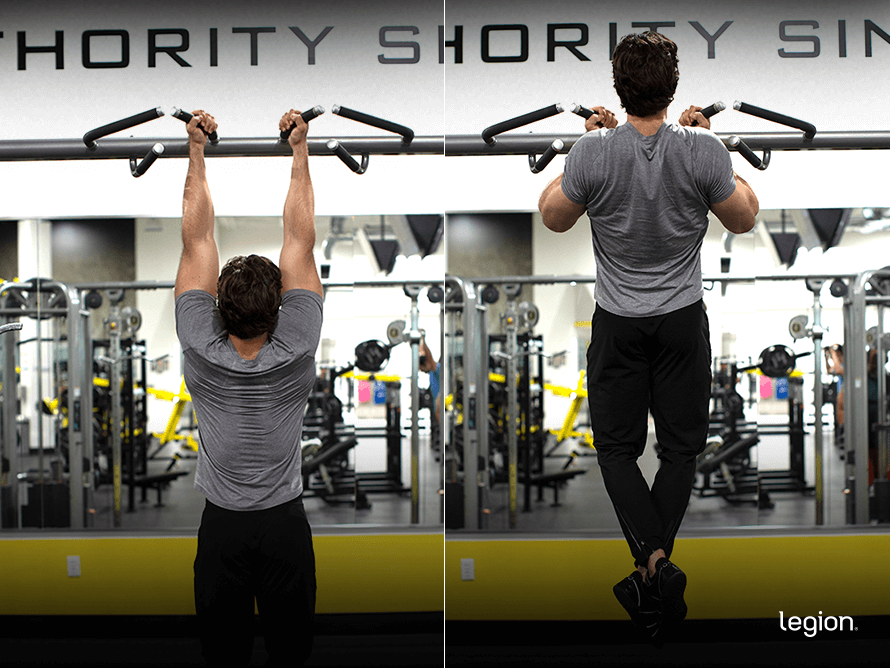
1. Set up
Grip a chin-up bar about shoulder-width apart and your palms facing toward you, then lift up your feet so that you’re hanging with your arms straight. You can cross your feet over each other if you find it more comfortable.
2. Pull
Without swinging your feet or knees, pull your body upward until your chin rises above your hands. Some helpful cues for this are to think about driving your elbows into the ground or smashing your chest into the bar.
The biggest mistake people make during the pull is relaxing their muscles as their chin nears the bar. Make sure you pull with your full effort throughout the entire rep.
The second biggest mistake people make is swinging their knees forward to build momentum. While this allows you to get more reps, it also makes the exercise easier and less effective. Think about arching your back and flexing your glutes to keep your lower body rigid.
3. Descend
Once your chin rises above your hands, reverse the movement and return to the starting position. This is a mirror image of what you did during the pull.
Keep lowering yourself until your arms are completely straight and you feel a deep stretch in your lats.
Don’t let your body fall back to the starting position or try to extend your arms slowly. The entire descent should be controlled but only take about a second.
Here’s how it should look when you put it all together:
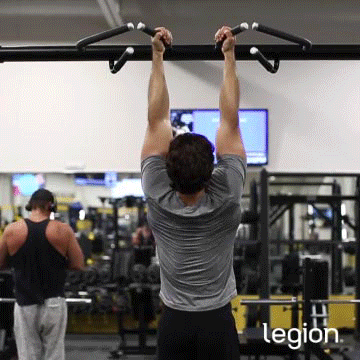
The Best Chin-up Alternatives
1. Chin-up Hold
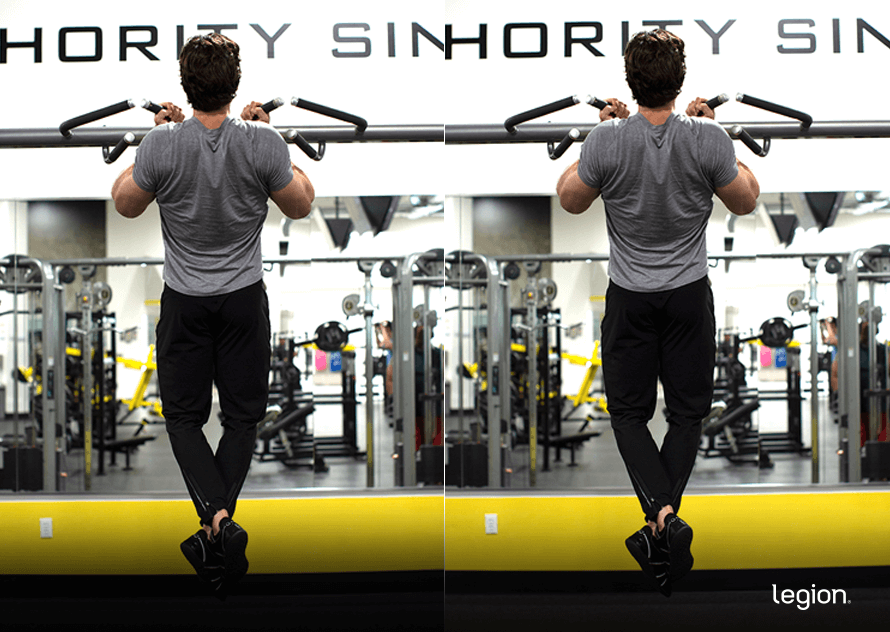
The chin-up hold involves getting into the top position of the chin-up (with your chin above your hands) and holding this posture for as long as you can before lowering yourself to the starting position.
If you’re completely new to weightlifting and can’t perform a single chin-up with good form, the chin-up hold is a fantastic exercise for building the strength you need to control your body while hanging from a chin-up bar.
2. Eccentric Chin-up
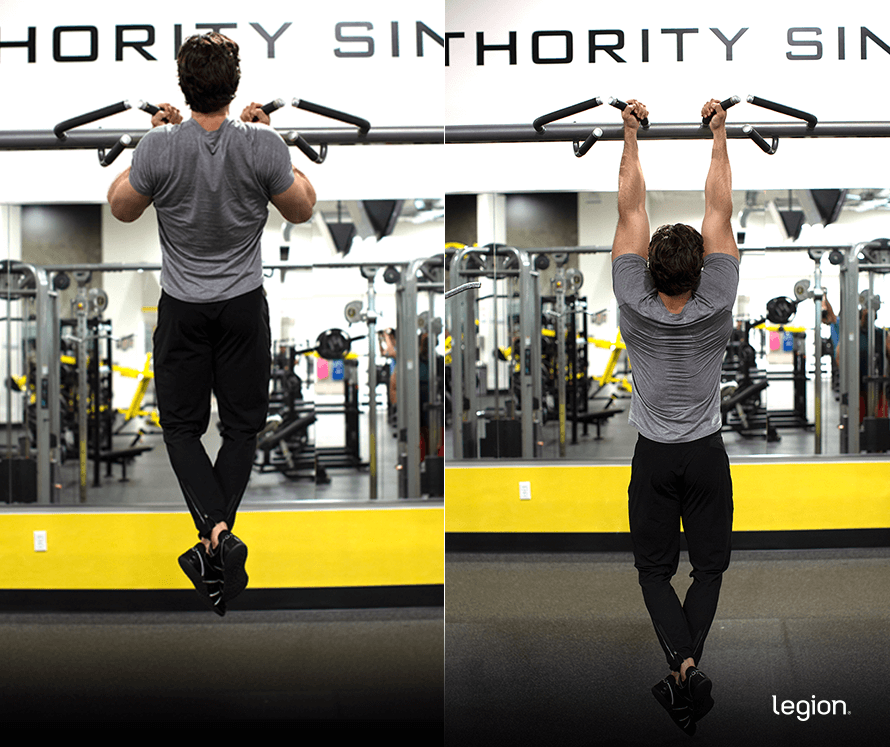
To perform the eccentric chin-up, get into the top position of the chin-up and slowly lower yourself to the bottom position, taking at least three seconds to reach the bottom of the rep.
Research shows that only doing the eccentric (lowering) portion of an exercise is superior to doing only the concentric (lifting) portion when it comes to gaining muscle and thus strength, which is why the eccentric chin-up is so effective at helping you progress toward doing a full bodyweight chin-up.
3. Machine-Assisted Chin-up
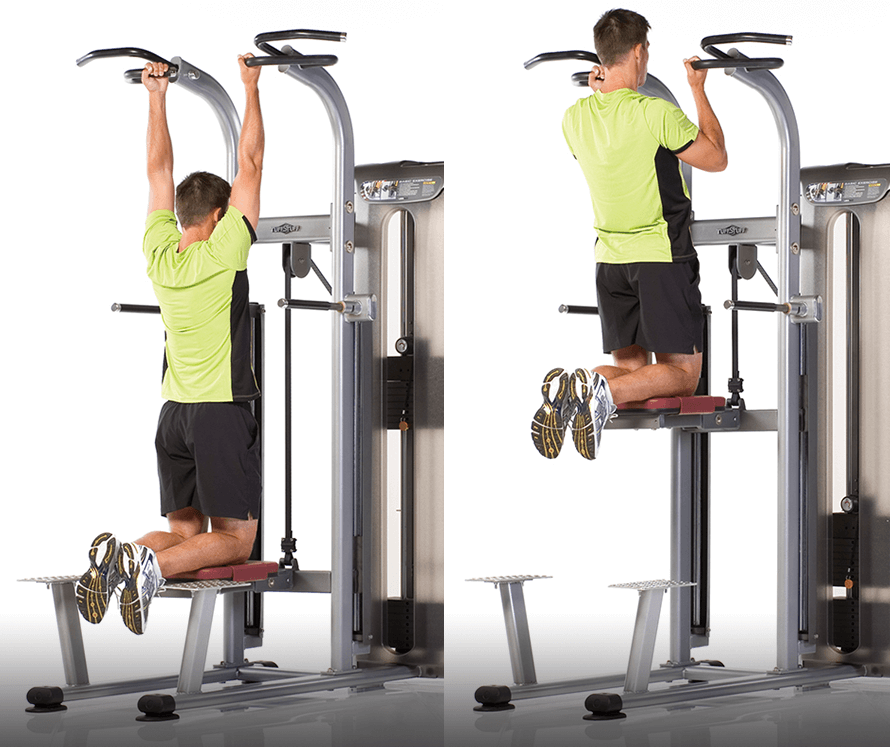
The machine-assisted chin-up is a chin-up substitute that uses a machine called an assisted chin-up machine. An assisted chin-up machine supports some of your body weight as you perform the chin-up, which effectively makes your body lighter and the exercise easier to perform.
The benefits of the machine-assisted chin-up is that it allows you to train the chin-up exercise through a full range of motion even when you don’t have the strength to perform it with your body weight, helping you develop the strength you need to perform the exercise unaided.
However, machine exercises are slightly less effective than free-weight exercises for gaining muscle and strength, which means any strength you build on the machine-assisted chin-up probably won’t translate to the bodyweight version perfectly.
4. Band-Assisted Chin-up
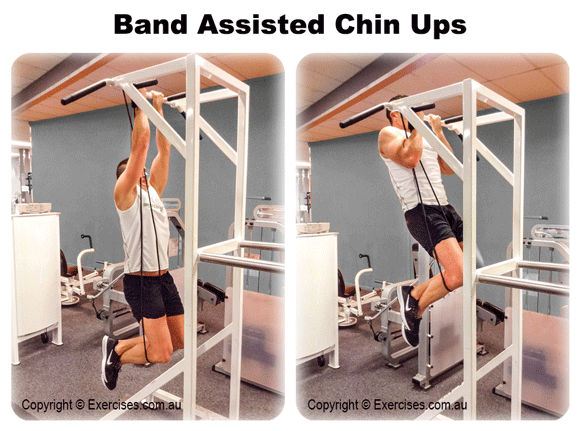
To perform the band-assisted chin-up, wrap a resistance band around a chin-up bar, place your feet on the band, and pull yourself up to the bar (the band will help support your body weight, making the exercise easier).
The band-assisted chin-up is similar to the machine-assisted chin-up insofar as it supports some of your body weight, which allows you to perform chin-ups using a full range of motion even when you’re not strong enough to do a bodyweight chin-up. The main difference is the band-assisted chin-up offers more help at the bottom of each rep when the band is most stretched, and less assistance at the top of each rep when the band is slackest. Conversely, the machine-assisted chin-up offers consistent assistance throughout each rep.
Both exercises are viable ways to build the strength you need to progress to bodyweight chin-ups, so use whichever you prefer or alternate between the two exercises every 8-to-10 weeks of training until you’re strong enough to do bodyweight chin-ups.
5. Weighted Chin-up
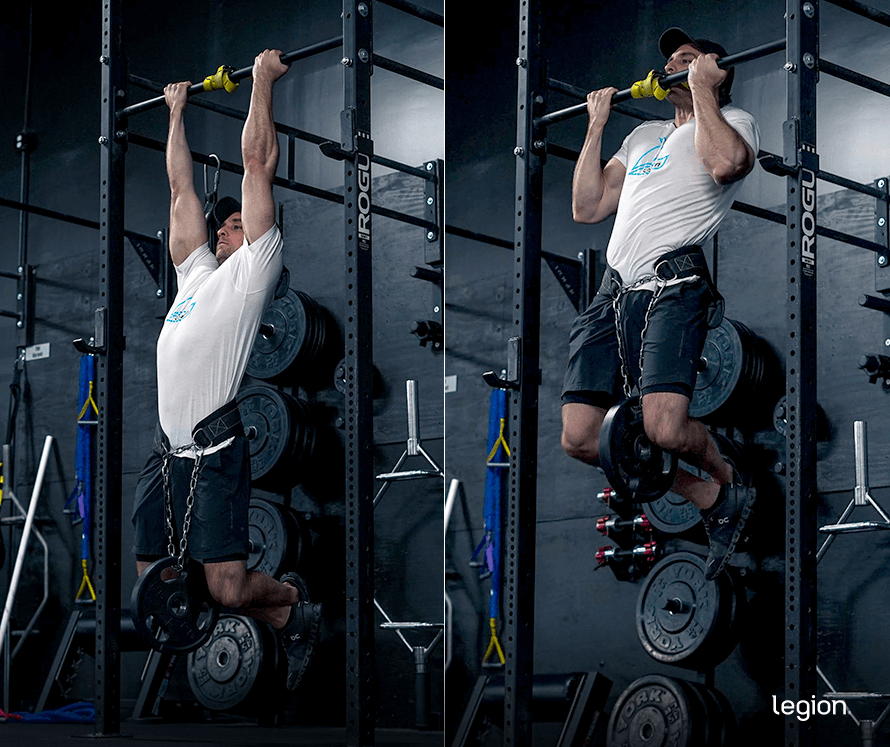
In the weighted chin-up, you snatch a dumbbell between your thighs or strap a weight around your waist. This allows you to progressively overload the chin-up when the bodyweight chin-up becomes too easy.
6. Close-Grip Chin-up
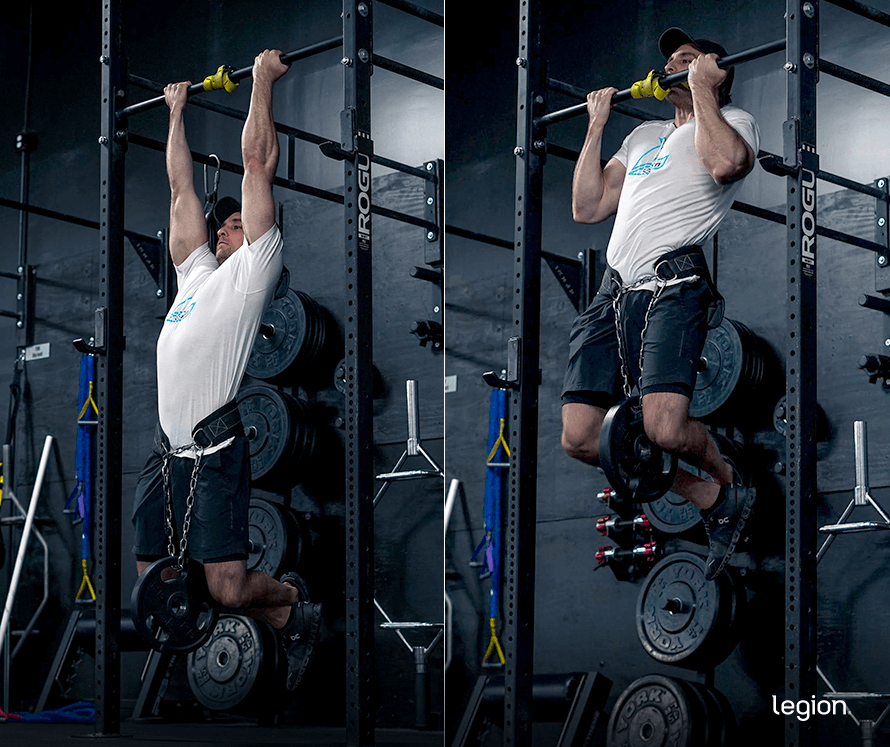
The close-grip chin-up is almost identical to the regular chin-up, only instead of taking a shoulder-width grip, you move your hands six-to-eight inches inward.
Some people say that the close-grip chin-up emphasizes the biceps more than the regular chin-up, but there’s no evidence that this is the case. That said, the close-grip chin-up is an enjoyable and equally effective alternative that you can use to liven up your training when you want a break from the regular chin-up.
7. Neutral-Grip Chin-up
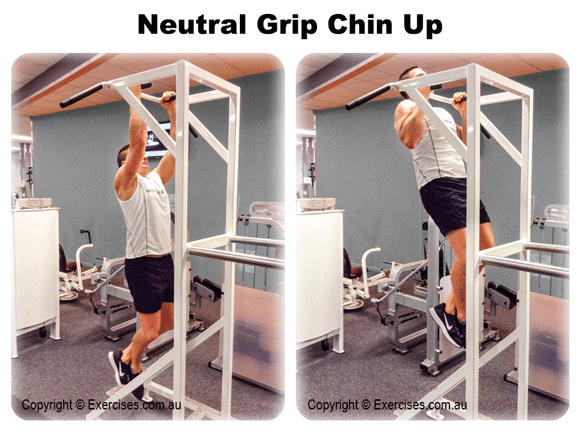
The neutral-grip chin-up is the same as the regular chin-up, except instead of using a supinated grip, you use a neutral grip (palms facing each other).
Despite what many people say, the neutral-grip chin-up and the regular chin-up train all of the same muscles to a similar degree, the only benefit of using a neutral grip for some people is it can feel more comfortable on your elbows and shoulders.
The Best Chin-up Workout
If you want to maximize muscle growth, research shows that it’s best to train your muscles in different ways, from different directions, and at different angles.
To accomplish this, it’s best to include other back exercises in your chin-up workouts, like these:
- Deadlift: 3 sets of 4-to-6 reps with 2-to-3 min rest*
- Chin-up: 3 sets of 4-to-6 reps with 2-to-3 min rest
- One-Arm Dumbbell Row: 3 sets of 6-to-8 reps with 2-to-3 min rest
- Lat Pulldown: 3 sets of 6-to-8 reps with 2-to-3 min rest
* Deadlifts are best performed first as they’re the most technically challenging and fatiguing.
FAQ #1: What’s the best chin-up alternative with resistance bands?
The banded lat pulldown mimics the movement in a chin-up or pull-up, only instead of you pulling your body up to a bar, you pull a band down to your body.
To perform the banded lat pulldown, wrap a resistance band around a chin-up bar, attic rafter, or some other point several feet above your head. Hold one end of the band in each hand and walk backward, allowing your arms to straighten, until all of the slack is out of the band.
Pull both ends of the band straight down until your hands are below your chin. Reverse the movement and return to the starting position. Here’s how it should look:
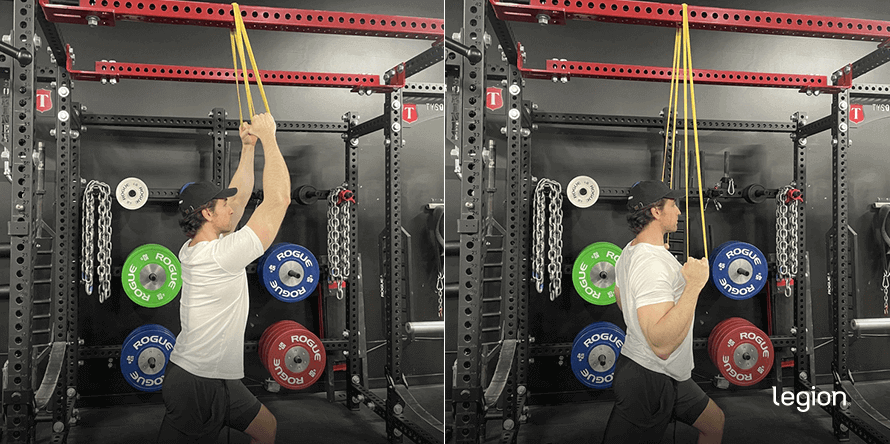
And if you want to learn more about the best resistance band exercises and workouts, check out this article:
The Definitive Guide to Resistance Band Workouts
FAQ #2: What’s the best chin-up bar for a home gym?
If your budget and workout space permit, a “power tower” is a good option because it’ll allow you to perform several exercises, including the chin-up, pull-up, dip, and captain’s chair leg raise.
The Weider Power Tower is simple, sturdy, and strong (it can hold up to 300 pounds), which makes it ideal for any home gym.
If you have limited space, a doorway chin-up bar, like this one from Prosource, is also a viable option.
Scientific References +
- Dickie, J. A., Faulkner, J. A., Barnes, M. J., & Lark, S. D. (2017). Electromyographic analysis of muscle activation during pull-up variations. Journal of Electromyography and Kinesiology, 32, 30–36. https://doi.org/10.1016/J.JELEKIN.2016.11.004
- Youdas, J. W., Amundson, C. L., Cicero, K. S., Hahn, J. J., Harezlak, D. T., & Hollman, J. H. (2010). Surface electromyographic activation patterns and elbow joint motion during a pull-up, chin-up, or perfect-pullupTM rotational exercise. Journal of Strength and Conditioning Research, 24(12), 3404–3414. https://doi.org/10.1519/JSC.0B013E3181F1598C
- Dickie, J. A., Faulkner, J. A., Barnes, M. J., & Lark, S. D. (2017). Electromyographic analysis of muscle activation during pull-up variations. Journal of Electromyography and Kinesiology : Official Journal of the International Society of Electrophysiological Kinesiology, 32, 30–36. https://doi.org/10.1016/J.JELEKIN.2016.11.004
- Koehler, J. D., & Helm, K. (n.d.). How Grip Variation Effects Shoulder Complex Muscle Activation During the Pull-Up. Retrieved July 17, 2022, from https://www.mayoclinic.org/tests-procedures/emg/about/pac-
- Urbanczyk, C. A., Prinold, J. A. I., Reilly, P., & Bull, A. M. J. (2020). Avoiding high-risk rotator cuff loading: Muscle force during three pull-up techniques. Scandinavian Journal of Medicine & Science in Sports, 30(11), 2205–2214. https://doi.org/10.1111/SMS.13780
- Youdas, J. W., Amundson, C. L., Cicero, K. S., Hahn, J. J., Harezlak, D. T., & Hollman, J. H. (2010). Surface electromyographic activation patterns and elbow joint motion during a pull-up, chin-up, or perfect-pullupTM rotational exercise. Journal of Strength and Conditioning Research, 24(12), 3404–3414. https://doi.org/10.1519/JSC.0B013E3181F1598C
- Farthing, J. P., & Chilibeck, P. D. (2003). The effects of eccentric and concentric training at different velocities on muscle hypertrophy. European Journal of Applied Physiology, 89(6), 578–586. https://doi.org/10.1007/S00421-003-0842-2
- Friden, J., Seger, J., Sjostrom, M., & Ekblom, B. (1983). Adaptive response in human skeletal muscle subjected to prolonged eccentric training. International Journal of Sports Medicine, 4(3), 177–183. https://doi.org/10.1055/S-2008-1026031
- Barakat, C., Barroso, R., Alvarez, M., Rauch, J., Miller, N., Bou-Sliman, A., & De Souza, E. O. (2019). The Effects of Varying Glenohumeral Joint Angle on Acute Volume Load, Muscle Activation, Swelling, and Echo-Intensity on the Biceps Brachii in Resistance-Trained Individuals. Sports (Basel, Switzerland), 7(9). https://doi.org/10.3390/SPORTS7090204










